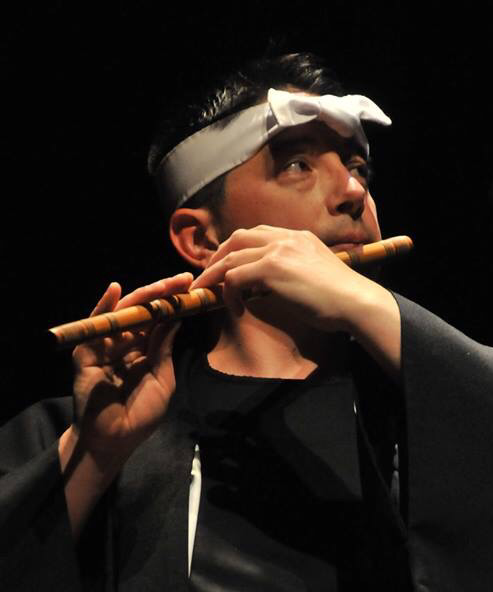Canada Council residency – NAE project Japan カナダ・カウンシルによる「なえ」ジャパンの研修
- Kokichi Kusano

- Jul 27, 2019
- 8 min read
(英文の下日本語あり)
With much appreciation, I want to first express my gratitude to the Canada Council for the Arts for funding my recently completed residency in Japan in leading up to the commencement of the NAE project which is now underway in Toronto.

In February of this year, the final grant funding was approved for the NAE project and this provided sufficient funds to undergo a residency in Japan. In the lead up to applying for this funding I reached out to industry leaders, Akira Katogi in folk and festival performance and Yusuke Kuribayashi a Noh-kan flute player actively performing in the Noh stage circuit in Tokyo, Japan and known abroad in performances in Europe and Asia.
For the NAE project which is a composition-based project that will produce new music based in Japanese music traditions, this residency was designed to provide valuable insights and techniques that will appear in the NAE project compositions. Notably, my time in Achi village with Akira Katogi focused on exploring the structure, composition and originating themes of a variety of regional festival music. As a modern art form, taiko ensemble music is widely seen as a 20th century fusion of modern Jazz influence with Japanese festival taiko, which evolved to ultimately introduce taiko music to new audiences globally. Much of the most iconic music of the genre, however, directly originates from ceremonial, theatre and festival music with traditions that are centuries old. In writing music for traditional instruments, it is sometimes too easy to fall into the habit of using them as catchy sound bites in otherwise modern music mixes. Leaving me to ask the question: “when and why do I want to hear these sounds?” as I approach the blank page and prepare to write using traditional instruments and influences. In several intense weeks living in the private dojo of Katogi-san and observing him in his work and practice, I believe his answer to these questions were to be found in our routine of mountaineering, farming, hunting and cleaning as much as they were to be found in any instruction or guidance provided in our time in the dojo.

Cutting to the second half of my residency, I moved from the mountainous rural setting of Achi village to the bustle of Tokyo where I was immediately and thoroughly steeped in the world of Noh theatre. My mentor Yusuke Kuribayashi, had me to his studio where I learned Noh-kan technique, history and music. As part of my study I regularly attended theatre performances, many of which he was performing in and spent my off hours in karaoke booths preparing and rehearsing for my lessons. I cannot emphasize enough how unique it was to be in such close proximity to Mr. Kuribayashi during this time. It was incredibly unique to see him in live public performance and to then be able to sit down in lessons and pick his brains about the performances I'd just seen. I suppose that those more familiar with the experience of live performance would value this otherwise secret world more, nevertheless it was invaluable.
Self-learning is a huge part of Japanese music and most technique is developed through brief and fast passed sessions of singing, beating rhythms and examining scores, with the remaining study a combination of observation of performance and long years of hands on struggle. The brevity of the period of study meant that I had to attend the equivalent of many months of study in a few weeks. The demands of the relentless schedule and on me to keep up, but equally upon my teacher, in being able to put aside the time amidst his very busy schedule were exhausting. Despite it all, I came away with volumes of resources and materials to build upon in my composition work, new insight and respect for this ancient art form and discipline, a challenging instrument and genre to explore and full of energy and optimism.
To both mentors, Mr. Akira Katogi and Mr. Yusuke Kuribayashi, I must express my deepest gratitude for their support and guidance. Neither of my mentors spared any chance to fulfil my requests for guidance. Both went well beyond what could be normally expected of an instructor to provide me with deeply informative and inspiring activities and experiences – having evidently taken a great deal of time to consider the nature of my project and planned their guidance and activities to maximize their potential utility to my ultimate goals.
I am truly grateful to the Canada Council for the Arts for this opportunity!
Looking back on my time there, flipping through my stack of note books and new music in the NAE project studio where I will continue to write and record the compositions for this project – I am overwhelmed to think what it took to come to this day and very excited to continue this work tomorrow.
深い感謝の気持ちを持ちまして、この度の日本での伝統芸能や能楽(笛)の研修の無事終了いたしたことをご報告申し上げるとともに、これらを可能にしたカナダ・カウンシルのご支援に対しましてのお礼を申し上げたいと思います。
今年の二月、カナダ・カウンシルにより、私が執り行うとしている「なえ」プロジェクトに対する助成金の授与が決まりまして、一部としては、プロジェクトのベースになる材料を集めるべく、日本での研修の支援も与えられました。今回のプロジェクトでは、日本の伝統音楽のルーツを探りながら、伝統芸能と能楽の業界での現役のリーダー、伝統芸能奏者で世界的に有名な加藤木朗さんとお能の笛方で、国際的にも活躍している栗林祐輔さんの元での数週感の大変濃縮された研修を申請いたしました。
日本の伝統的な音楽を取り入れながら新たな音楽を作っていくこの「なえ」プロジェクトにとっては、技術的なノーハウを獲得する目的もあれば、自分にとって新たな刺激を受けながら、創作のインスピレーションを集める目的もありました。例えば、加藤木朗さんとの長野県阿智村での研修合宿は、地方の伝統芸能に現れる形式、構成と由来を勉強した。今時でいう「和太鼓」というものは、現代的に発明されたジェヌルであると言われています。例えば、西洋ジャズでのパッカションを影響として受け入れた伝統楽器の太鼓を使った奏法として生まれたのは前世紀戦争後のことであるそうです。しかし、今でも世界的に日本の和太鼓のイメージとして最も代表的に知られている曲の中には、逆に昔ながらのお祭りや神楽などに現れるものを舞台化されたものが多いのではないだろうか。やはり、日本の歴史と文化に根深くつながっている芸能の曲も、現代人に伝わる旨さと熟された味があるんだろうけど、作曲家として空のページを前にした時、これらの楽器のための音楽を作るにあたり、ただでさえ現代的なセンスで伝統的な楽器を「サウンドビット」としていかすなら、圧倒的に最新の作曲技術を研究した方がいいと思われる。日本の伝統芸能を愛してきた自分にとっては、新作の作成に向かって、この楽器やスタイルを聞けば、どんな気持ちになるか、どのようなきっかけや時に聞きたくなるかを探ることから始める。加藤木さんの道場での研修期間、日々の山、畑、それから道場での作業とお稽古の中に、これらの質問に対する答えが潜んでいたかのように感じました。
長野県での研修期間があっという間に終わりになり、研修後半の予定の通り、東京へ向かった。東京に着いて間も無く、そのまま能楽の世界に突入した。それまでには一度もライブで見たことのない能舞台を拝見した翌日から、栗林さんのスタジオでお稽古が始まった。そこで能楽ではただ「笛」と呼ばれる「能管」の音楽、歴史や技術についての勉強を行なった。能舞台の見学とレッスンで日々のスケジュールが埋まり、余る時間があればカラオケ・ボクスを借りて必至に自主練を続けた。優れた演奏の直後で出演のご本人とレッスンを受けるのは、なかなかいい機会だ。本物の舞台について直接語ってくださることは、演奏に詳しい人ほど価値ある秘密情報である。
カラオケ・ボクスでの練習だけど、狭い部屋で能管を吹くとあとで耳が「キーン」と鳴るので、最初は耳栓をさすか悩んだが、音色の本質を聞こえなくなる欠点があったが、夜中すぎまで長くやるとやはり耳に対する負担が気になったので、指遣いのお稽古だけだとして、耳栓を指すことにした。カラオケ・ボクスで能管のお稽古をすると、カウンターに文句を言う隣のお客さんが出るかなと思ったら、ある日、帰ろうとしてカウンターで精算している時、「能管を吹いていたお客様ですよね」と言われ、「あ、そうですが」と答えてみると、「私は能楽大好きです、学生のときには謡いをやっていました」と言い、「またいつでもきてくださいね」と言われてびっくりしました。厳しいお稽古の必要に関しては、今回の能管の研修では、普段長い間に渡り勉強する内容を、栗林さんの大変親切なご配慮により数週間でカバーできるように濃縮的にハードなスケジュールで行うように予定してくださっていたので、一度教えてくださったことを、普段のように、何度もレビューすることもできず、次から次へと進まなければならなかった。一つ一つのレッスンの内容を最大に身につくためには、しっかりお稽古の時間をとる必要があった。トロントですら大きい音を出す練習ができるところを見つけるのに苦労するが、東京ではなおさらのことと思うところに、日本のカラオケ・ボクスは、少しお金かかりましたけど、欠かせない存在となってくれた。わずかな期間に集中的に研修を行なって、さすがに疲れて終わりましたけど、これからの作曲に活かせられる貴重な材料をたくさん獲得して、新たに能管の勉強もはじめ、これから続く「なえ」プロジェクトの実現へのエネルギーと肯定感を心いっぱいにして帰国できた。
「なえ」プロジェクトのジャパン研修の実現を可能にしてくださった加藤木朗さんと栗林祐輔さんのご協力に対して深い感謝を表したいと思う。研修の目的に全力的に立ち向かってくださったお二人は、普通に期待できない丁寧なご指導とガイダンスをくださり、作曲の種になるだろういうような経験やイベントを企画してくださるなど、今トロントで作曲に取り組んでいる私はただただ、感謝の気持ちでいっぱいだ。そして、これらを全て可能にしてくださったカナダ・カウンシルに対して、お礼を申し上げたい次第である。
本日、プロジェクト実現のために新たに開いたお稽古場、または作曲スタジオ(かってに「なえ道場」と呼んでいる)で、それぞれの研修期間で記した覚書やメモを振り返って読みながら、ここまで来るのにどんな長い旅だったか思うと謙虚な気持ちになり、そして、これから「なえ」プロジェクトで未来に立ち向かい、やる気で胸が破れそう。
-Kokichi




Comments